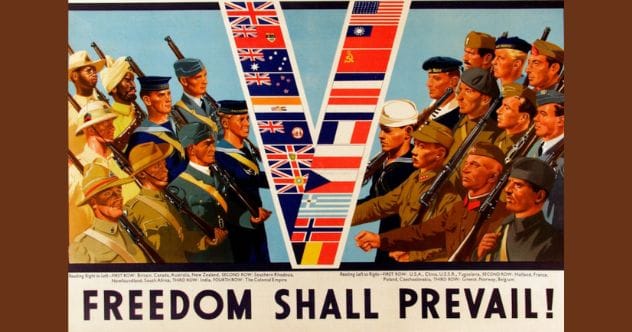World War II wasn’t just fought on distant battlefields; it reached deep into the heart of every Allied nation, transforming daily life in ways previously unimaginable. From the skies above to the kitchens and factories below, ordinary citizens faced extraordinary challenges. Hardships like aerial attacks, shortages of labor, food, and essential materials became the norm. Everyone, regardless of age or gender, had a part to play. The efforts on the home front were crucial, helping to secure victory for the Allied forces. However, these times also brought about lasting changes, some for the better, and others, undeniably, for the worse. Let’s explore ten profound ways WWII reshaped the Allied home front.
10. Aerial Bombardment
Starting in 1939 and lasting until 1945, the German air force, known as the Luftwaffe, waged a relentless aerial bombardment campaign against the United Kingdom and other nations. For six long years, Londoners endured nightly attacks from heavy explosives and incendiary devices. This terrifying onslaught wasn’t limited to the capital; many other British towns, including some of England’s most picturesque cities, suffered. In the war’s final two years, rocket attacks added another layer of fear. London, a city of eight million, swelled to ten million when counting its wider metropolitan area, placing a massive number of civilians at risk. An observer described the sight of hundreds of Luftwaffe bombers as an “amazing, impressive, riveting” swarm, filling the sky like “bees around their queen.” The city’s East End docks, as well as Central, West, and South London, faced repeated bombings, followed by assaults on the suburbs. Tragically, neither people, their homes, nor cherished landmarks like Buckingham Palace (struck sixteen times) and the Palace of Westminster (hit fourteen times during the 1940-1941 Blitz) were spared. Historic churches and cathedrals also sustained severe damage, and the Luftwaffe even targeted rural areas.
9. All-American Girls Professional Baseball League
When the United States entered World War II in 1941, Major League Baseball faced a challenge. President Franklin D. Roosevelt supported its continuation, but players were swapping their sports uniforms for military ones. Philip K. Wrigley, the chewing gum magnate and owner of the Chicago Cubs, stepped up to the plate. In 1943, he founded the All-American Girls Professional Baseball League Players Association. Wrigley initially saw the women’s league as a temporary wartime solution, expecting it to disband once the conflict ended. However, the league proved incredibly popular, drawing over 900,000 fans during the 1948 season alone. It continued for twelve successful years, featuring over 500 players, before finally disbanding in 1954. This remarkable chapter in sports history later inspired the 1992 hit movie A League of Their Own, starring Tom Hanks, Geena Davis, and Madonna.
8. Blackouts
Blackouts were a simple yet highly effective defense against nighttime aerial attacks. By extinguishing all lights – from vehicle headlights and streetlights to residential lighting and even the glow of a cigarette – enemy pilots found it much harder to identify targets. In England, the ban on lights was absolute, plunging entire cities and coastlines into darkness. Britain’s Air Ministry, anticipating “sudden air attacks” with many casualties, knew that without ground lights, enemy bombers would struggle with navigation and targeting. The nation’s Air Raid Patrol urged every citizen to help enforce these blackout regulations. Driving at night without headlights was described as “confusing, frightening, and dangerous,” leading to an increase in accidents. Drownings occurred when drivers veered off bridges. In one instance, a passenger mistook an unscheduled train stop for his station, stepped off, and fell eighty feet into a viaduct. While crime like pickpocketing did rise as thieves exploited the darkness, the increase wasn’t as dramatic as some feared, partly because criminals worried about confronting residents during break-ins. Similar blackout restrictions were enforced in the United States and other countries until they were finally lifted for good in April 1945.
7. Bomb Shelters
In Britain, underground bomb shelters provided crucial protection during aerial bombardments. The Anderson shelter, named for Home Secretary Sir John Anderson, was a common sight. This corrugated iron structure, measuring about 6ft 6in by 4ft 6in (2m by 1.4m), could protect up to six adults. The government ordered 2.5 million of them, and though only 100,000 were sold, they proved effective, with many families surviving inside while their homes were destroyed. However, these shelters were far from comfortable. Being cramped, underground, and not soundproof, they often amplified the terrifying sounds of an air raid: the whistle of falling bombs, the roar of RAF fighters, and the thunder of British anti-aircraft guns. Public shelters, some built in parks, were also available. Tragically, larger public shelters could be dangerous. During a mass rush into an Underground station shelter, a woman tripped on the stairs, leading to a devastating crush that killed 173 people and injured over 60.
6. Censorship
Following the attack on Pearl Harbor on December 7, 1941, President Roosevelt established the Office of Censorship just twelve days later. This office was authorized to edit or suppress “any message entering or leaving the United States by mail, cable, or radio.” This domestic censorship policy remained active until Japan’s surrender on August 15, 1945. Other countries, like Canada under its War Information Board, also implemented government censorship. While some censorship might have seemed minor or random, much of the censored material was highly significant, such as news about the development of the atomic bomb. Byron Price, the director of the Office of Censorship, stated that the news media voluntarily agreed to limit their reporting for the country’s good. Although Price admitted to some “minor leaks,” he believed they were likely unintentional. He was largely satisfied that “the long work on the atomic bomb was the best-kept single secret of the war.”
5. Propaganda
Propaganda during World War II appeared in many forms, including films, posters, and even comic books. Paul S. Hirsh, in Pulp Fiction: The Secret History of Comic Book Imperialism, notes that comic books – being visual, easy to read, and exciting – were widely read by both soldiers and civilians. This made them a powerful tool for the Writers War Board to deliver propaganda. Comic book companies also saw this as an opportunity to demonstrate their patriotism while attracting millions of new readers. Heroic soldiers like DC Comics’ Sgt. Rock became popular figures. He was depicted as enlisting early in WWII and representing the common enlisted man. Similarly, Marvel Comics’ Captain America symbolized the ideal officer who could protect soldiers during the war. In fact, the March 1941 cover of Captain America Comics showed the hero in his red, white, and blue costume punching Adolf Hitler. Marvel’s editor Stan Lee himself pointed out that even before the U.S. officially entered the war, “many of our super heroes, especially Captain America, the Human Torch, and the Sub-Mariner, were already fighting Hitler and the Nazis.”
4. Factory Girls and Military Auxiliaries
Adolf Hitler’s belief that women’s place was solely in the home and maternity ward stood in stark contrast to the realities on the Allied home front. American women stepped into factory jobs vacated by men who joined the military. They continued to manage their homes and raise children while also working in defense plants and volunteering for war-related organizations. Some even served as “conducterettes” on trolleys. Women’s contributions didn’t stop there. According to historian Stephen Ambrose, they also “managed the finances and learned to fix the car.” Furthermore, women served in the auxiliaries or reserves of the U.S. Army, Navy, Marine Corps, and Coast Guard. They took on roles as clerks, truck drivers, aircraft mechanics, lab technicians, parachute riggers, radio operators, photography analysts, military pilots, test pilots, and training assistants. Although they didn’t serve in combat roles, many worked as nurses near the front lines; 16 were killed by direct enemy fire, and 68 were captured as POWs in the Philippines. General Dwight D. Eisenhower credited American women’s valiant efforts as a significant factor in the Allies’ success, suggesting the war might have had a different outcome without their help.
3. Land Girls
With a vast number of men away fighting, the UK faced a severe shortage of farm labor. A call for volunteers, later supplemented by conscripts, led to the formation of a corps of 80,000 “Land Girls,” as these dedicated women were popularly known. Initially, their presence wasn’t universally welcomed, but their relentless hard work soon won over any skeptics. These women proved highly capable, mastering tasks such as driving tractors, thatching roofs, sharpening wooden stakes for fencing, and packing sugar beet into silos. Their contribution was vital to maintaining food production on the home front.
2. Lumber Jills
Another crucial role women in the UK undertook was substituting for lumberjacks who had joined the military. Known informally as “Lumber Jills,” these women were part of the Women’s Timber Corps, established in 1942 as a branch of the Land Army. Their tasks included felling and measuring trees, loading lumber onto trucks, and driving vehicles. Their efforts were essential for supplying timber to wartime industries. Though their working hours were slightly shorter than those of the Land Girls (from 7:00 am to 4:30 pm), the work was incredibly demanding. The fact that Lumber Jills had to pass a stricter medical examination than Land Girls indicates the physical nature of their job. Joy Smith, who joined the Women’s Timber Corps at eighteen in 1943, recalled learning to “wield an ax” and a crosscut saw, operate a buzz saw, fell trees, cut them into four-foot lengths, and load them onto “lorries.” After training, she and other Lumber Jills were deployed across the UK, often housed with local families, to carry out vital logging operations.
1. Japanese Internment Camps
Perhaps the most tragic and unjust change on the home front during World War II was the establishment of Japanese internment camps in the United States, Canada, and Australia. In February 1942, President Roosevelt signed Executive Order 9066, authorizing the removal of individuals from broadly defined military areas. This led to the forced relocation of people of Japanese descent from the entire West Coast. Rachel A. Bailey, in The Japanese Internment Camps, provides a harrowing first-person account of her family’s experience. Her mother, anticipating the order, sold their belongings for very little. When the notice came, the family was bused to a reception station, allowed to bring only what they could carry. They were identified by numbers on their bags and housed in cramped barracks with minimal facilities, including a single light bulb and straw-stuffed cots. Bathrooms were communal, and meals were taken in a mess hall. Camps like Manzanar in California were desolate, surrounded by guard towers. Similar injustices occurred in Canada, where, under the War Measures Act, the government detained and dispossessed over 90 percent of Japanese Canadians, seizing and selling their property to fund their detention. Conditions in Canadian camps were also grim. In Australia, a May 1941 War Cabinet decision led to the internment of nearly all Japanese males over 16, and later, very few first- or second-generation Japanese, including elderly people in nursing homes, escaped internment.
Conclusion
World War II undeniably left an indelible mark on the Allied home front. The period brought forth incredible resilience, innovation, and community spirit as civilians adapted to unprecedented challenges. From women taking on new roles in industry and agriculture to entire populations enduring blackouts and bombings, life was profoundly altered. While many changes were temporary adaptations to wartime needs, others, like the shifted roles of women and the painful legacy of internment, had lasting societal impacts. The home front was not merely a backdrop to the war; it was an active, essential front line where the course of history was also shaped, for better and for worse.
Which of these WWII home front changes do you find most impactful? Share your thoughts in the comments below!










